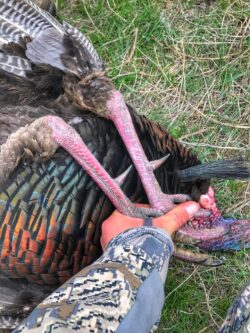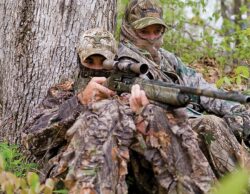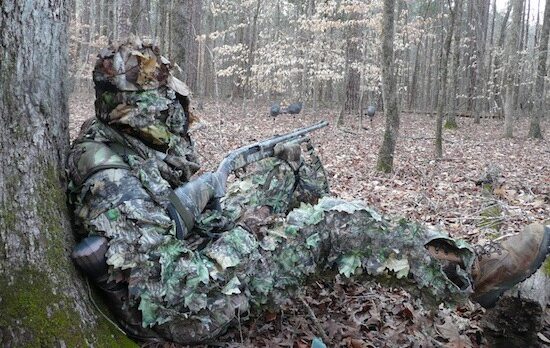 Not everyone is a Turkey chaser. These amazing birds are not an easy target. Hunting Spring Gobblers takes incredible patience and skills. Tactics and strategy will help create an opportunity for success, but so many things can go wrong.
Not everyone is a Turkey chaser. These amazing birds are not an easy target. Hunting Spring Gobblers takes incredible patience and skills. Tactics and strategy will help create an opportunity for success, but so many things can go wrong.
Some hunters prefer a surer thing. Wild Turkeys are anything but. They have superb eyesight and are great survivors. The slightest movement and it’s over. The target is small. You need to put several or more shotgun pellets in a narrow beck with an ugly head. A huge Gobbler will be around 20-25 pounds. Jakes, younger males, will be 9-13 lbs.
Some hunters tag birds that are patterned by a feed or crop pile. No calling is involved. Just get there when the birds have shown a pattern to feed. This is called shooting turkeys, not hunting.
A true Gobbler hunt means getting up an hour before daylight. Trekking into a position near where the turkeys have roosted or a high point where you can listen for morning calls. Locating a roost means “Putting the birds to bed”, the night before.
Most of the turkey hunt happens before noon. The birds that gobble after 8-9 o’clock are the ones I have the best luck with. These gobblers have already mated with several early riser hens and are still looking for some action. Most hens are on the nest by this time. Now is when you make sexy, and irresistible purrs to lure in this horny Gobbler.
If things go to plan, a well camouflaged hunter will be set up within 100 yards of the roost. When the turkeys begin making a tree call, the hunter can mimic it. Sometimes an owl hoot will wake up the sleepy birds. Owls are a major turkey predator.
 Once you locate a gobbler, quickly get within 100 yards, and set up. I have had best luck calling birds down a ridge, from below to me, or at the same level. Birds rarely cross a watershed. Calling a bird downhill gives the birds a visual advantage. Sey up along an edge, a ditch, or fence line. Sit against a tree, bush, post, or…
Once you locate a gobbler, quickly get within 100 yards, and set up. I have had best luck calling birds down a ridge, from below to me, or at the same level. Birds rarely cross a watershed. Calling a bird downhill gives the birds a visual advantage. Sey up along an edge, a ditch, or fence line. Sit against a tree, bush, post, or…
Next, the hunter needs to make a cackle call, which mimics a turkey flying down onto the ground. A few soft clucks and purrs will help to seal the deal. If you have a decoy out, the birds may come right in. Position the young gobbler decoy in range, facing your position. Hen decoys should face off to the side.
Things to consider!
Use complete CAMO. A head net or full-face paint helps. The net keeps the bugs away. Camo gloves help as well.
The gobbler decoy should be where you plan to kill the bird. Use hen decoys with an immature Jake decoy. A mature gobbler decoy may scare off other less aggressive gobblers.
Decoys attract other hunters. Wrap an orange ribbon above your blind site.
Too much calling is not helpful. Call as little as you need to. Let the bird find you.
Not all birds gobble when they come into range. You may just hear a rumbling, thumping sound as the bird goes into full display and drags its wingtips.
Tell a story when calling. Mimic what you hear.
Deflect your call to the flanks of your position. Don’t give away your exact position.
Sit against a tree or structure to blend into the terrain. Use a cushion to help stay comfortable.
Sit in a position ready to shoot. Prop the gun on your knee or use a shooting stick. Aim at where you expect the shot. It sometimes can take over an hour for the gobbler to fully commit.
DON’T MOVE!!!
If the bird hangs up out of range, use your hat or a wing to scrape the leaves/soil next to you. Do this discreetly. A few soft purrs will help.
A mouth/Diaphragm call is the best choice.
Box calls make natural sounds.
Aim where the feathers stop, and the neck begins. Take your first, best shot. Make sure that the bird has a beard to be a legal gobbler.
Once you shoot the bird, immediately get to it. The flopping bird may need to be grabbed. Grab the bird by the neck, not the legs. The spurs can slash and cut you. Swing the bird to break its neck. Shooting it again will just ruin the eating.
Do not shoot beyond 50 yards, even if you can. The whole point is to bring the bird in CLOSE! When I teach seminars, I preach this strategy. “Do you want to just have sex, or do you want to make love?” This is true for archery elk hunting as well. The thrill and excitement of a close and tight bird or elk is why you are in the woods. Long range shooting is best served in the Fall or rifle season.
Spring hunting is a great time to camp out. You can also expect to find sheds and morel mushrooms. Spring trout fishing is also in session. Plan to feast on plenty of great camp food and snacks.
Back in the day, Montana Spring turkey hunting was about shooting birds at long range with a rifle. In the Spring, only archery and shotguns are legal. Long range rifle shots are deemed to be unethical and an unfair advantage. Why would you ruin the chance to call in a great Gobbling critter?
Trek away!
Montana Grant




